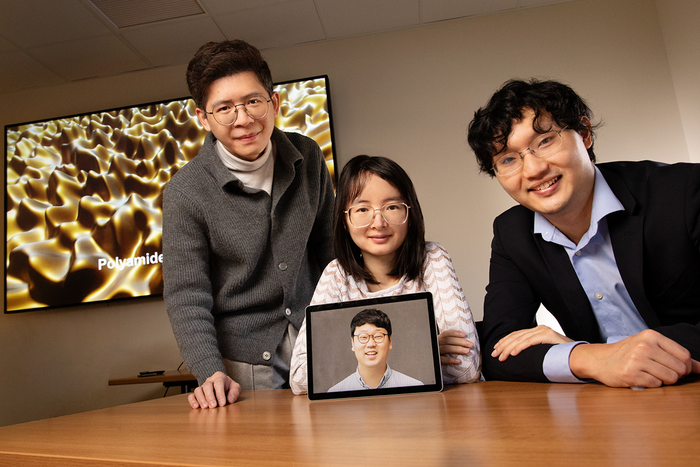CHAMPAIGN, Ill. — Morphogenesis is nature’s way of building diverse structures and functions out of a fixed set of components. While nature is rich with examples of morphogenesis – cell differentiation, embryonic development and cytoskeleton formation, for example – research into the phenomenon in synthetic materials is scant. University of Illinois Urbana-Champaign researchers are taking a step forward using electron tomography, fluid dynamics theories and machine learning to watch soft polymers as the polymers learn from nature.

Credit: Photo by L. Brian Stauffer
CHAMPAIGN, Ill. — Morphogenesis is nature’s way of building diverse structures and functions out of a fixed set of components. While nature is rich with examples of morphogenesis – cell differentiation, embryonic development and cytoskeleton formation, for example – research into the phenomenon in synthetic materials is scant. University of Illinois Urbana-Champaign researchers are taking a step forward using electron tomography, fluid dynamics theories and machine learning to watch soft polymers as the polymers learn from nature.
The new study, led by Qian Chen, a professor of materials science and engineering; Jie Feng, a professor of mechanical science and engineering; and Xiao Su, a professor of chemical and biomolecular engineering; is the first to demonstrate nanoscale morphogenesis in a synthetic material. The study is published in the journal Science Advances.
“You may see the filters in your home water purification systems as simple membranes with pores, but they are much more sophisticated when we zoom in using electron tomography,” said former Illinois postdoctoral researcher Hyosung An, the study’s lead author and a professor of petrochemical materials engineering at Chonnam National University in South Korea. “By capturing images of sample membranes from a rotatable stage, we can reconstruct their full 3D morphology at sub-nanometer resolution.”
Click here to see a video detailing this research. [HYPERLINK: https://youtu.be/Vr_mkSyNte4]
Imaging from varying angles allows the researchers to see the intricate 3D structure of the membranes – with all their crumples, inner voids and networks – at a spatial resolution not possible before. The structures are so complex that traditional shape descriptors, like radius and length, are invalid, said Chen, who led the experimental portion of the study.
To help team members get their heads around the complex nature of the membranes, graduate students John W. Smith and Lehan Yao developed a machine learning-based workflow to digitize the structure parameters.
Smith and Yao’s efforts made an immediate impact.
“We can see morphological similarities between the synthetic membranes and biological systems,” said Feng, who led the study’s fluid dynamics and reaction modeling with postdoctoral researcher Bingqiang Ji. “We tested several models and found amazing quantitative agreement with conventional theories that explain structures found in macroscopic biological systems, such as patterns on fish skin. The molecules are smart, and we expect that similar morphogenesis occurs in other soft polymer materials – we simply didn’t have the tools to see them until now.”
“The impact goes beyond mechanistic understanding,” said Su, who led the membrane separation studies alongside graduate student Stephen Cotty. “One long-standing puzzle of separation science has been how to correlate membrane morphology and performance. Our study combines the detailed nanoscale understanding of the morphology with membrane filtration testing, with important implications for various separation contexts.”
The researchers envision a wide range of applications of this development that may expand the functionality of soft nanomaterials like polymers, vesicles, microgels and composites – all through morphogenesis.
“By casting 3D nanomorphology during formative chemical reactions, this advance will benefit the design of other materials of complex 3D morphologies,” Chen said. “The technologies behind devices like actuated nanomachines and other bioinspired materials with precise 3D interfacial morphology whose shapes can affect biological interactions may all advance by our findings.”
The Air Force Office of Scientific Research, the Defense University Research Instrumentation Program and the National Science Foundation supported this study.
Chen and Feng also are affiliated with the Materials Research Laboratory; Chen also is affiliated with bioengineering, chemistry and chemical and biomolecular engineering. Chen and Su also are professors within the Beckman Institute for Advanced Science and Technology; Su also is affiliated with civil and environmental engineering at Illinois.
Editor’s notes:
To reach Qian Chen, call 217-300-1137; email [email protected].
The paper “Mechanism and performance relevance of nanomorphogenesis in polyamide films revealed by quantitative 3D imaging and machine learning” is available online (link coming soon) and from the U. of I. News Bureau. DOI: 10.1126/sciadv.abk1888
Journal
Science Advances
DOI
10.1126/sciadv.abk1888
Method of Research
Experimental study
Subject of Research
Not applicable
Article Title
Mechanism and performance relevance of nanomorphogenesis in polyamide films revealed by quantitative 3D imaging and machine learning
Article Publication Date
23-Feb-2022
COI Statement
N/A



